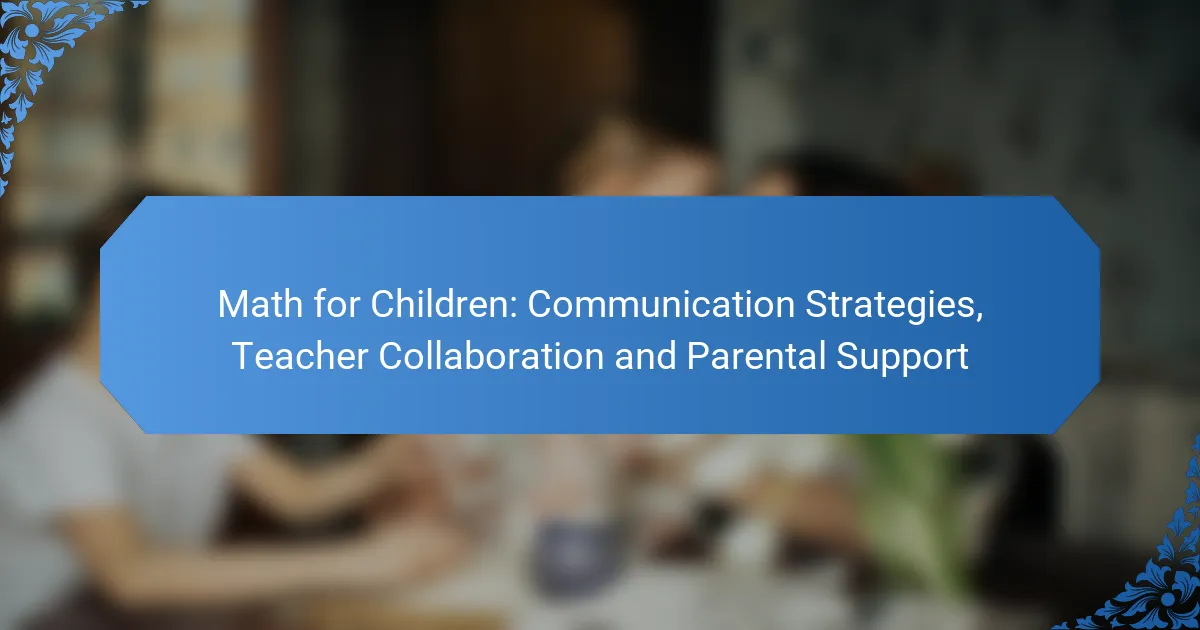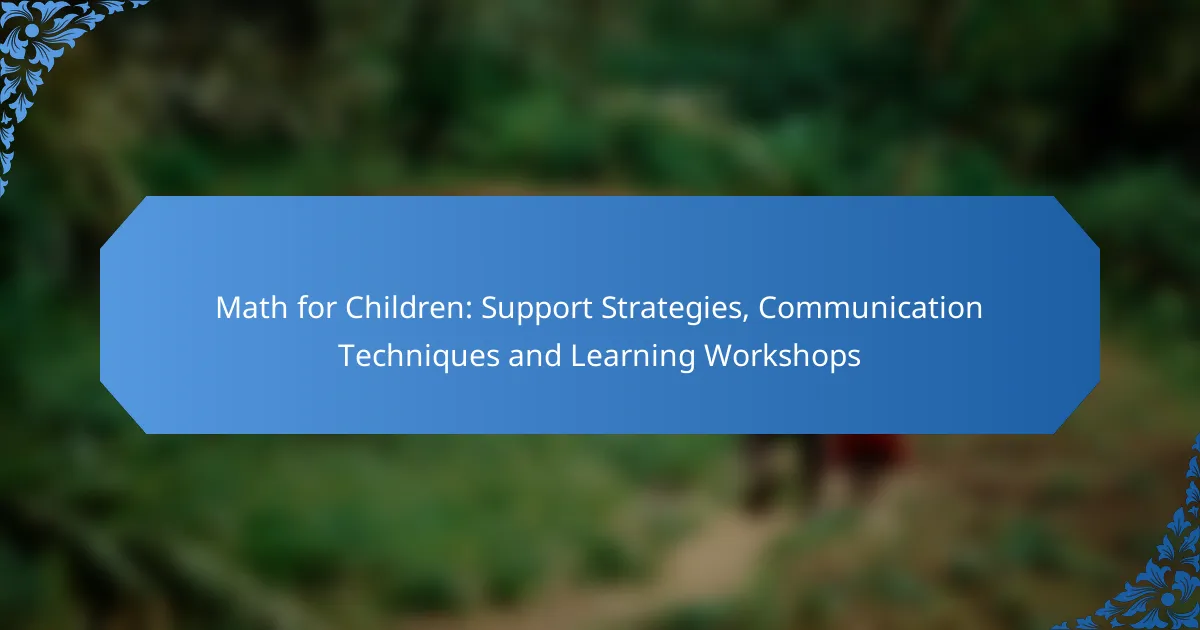Creating a supportive home environment is crucial for enhancing children’s math learning, as it encourages curiosity and engagement with mathematical concepts. By utilizing effective learning tools and participating in family activities that promote math skills, families can foster a positive attitude towards mathematics and help children develop essential skills in a fun and practical way.

How Can Home Environment Enhance Math Learning for Children?
A supportive home environment can significantly boost children’s math learning by providing resources, opportunities, and encouragement. By creating a space that fosters curiosity and engagement with math concepts, families can help children develop essential skills and a positive attitude towards mathematics.
Creating a Math-Friendly Space
Designing a math-friendly space involves organizing an area where children can comfortably explore math concepts. This can include a dedicated table for math activities, equipped with supplies like paper, pencils, and manipulatives such as blocks or counting beads.
Consider adding math-related posters or charts that display numbers, shapes, and basic operations. These visual cues can stimulate interest and serve as helpful references during learning activities.
Incorporating Math in Daily Routines
Integrating math into daily routines makes learning natural and engaging. For example, involve children in cooking by measuring ingredients, which teaches fractions and volume in a practical context.
Additionally, use shopping trips to practice addition and subtraction by comparing prices or calculating totals. These everyday activities can reinforce math skills in a fun and relatable way.
Utilizing Visual Aids and Resources
Visual aids and resources enhance understanding by providing concrete representations of abstract concepts. Use items like number lines, charts, and educational apps to make learning interactive.
Consider incorporating games that require counting, sorting, or pattern recognition. These tools not only support math learning but also make it enjoyable, keeping children engaged.
Encouraging a Growth Mindset
Fostering a growth mindset helps children view challenges in math as opportunities for growth. Encourage them to embrace mistakes as part of the learning process, reinforcing that effort leads to improvement.
Use positive reinforcement to celebrate their progress, no matter how small. This approach builds resilience and a love for learning, which is crucial for success in math.
Setting Up Math Play Areas
Creating designated math play areas can make learning feel like a game. Set up spaces with puzzles, board games, and interactive activities that incorporate math skills.
Ensure these areas are easily accessible and inviting. Rotate materials regularly to maintain interest and challenge children with new concepts, keeping their math learning dynamic and engaging.

What Learning Tools Are Effective for Teaching Math?
Effective learning tools for teaching math include a variety of resources that engage children and enhance their understanding of mathematical concepts. These tools can range from digital applications to physical manipulatives, each offering unique benefits for different learning styles.
Math Apps for Children
Math apps for children provide interactive and engaging ways to practice math skills. Many of these applications are designed for various age groups and skill levels, making them accessible for young learners. Popular examples include apps like Prodigy and Khan Academy Kids, which offer games and challenges that reinforce math concepts.
When selecting math apps, consider features such as progress tracking, user-friendly interfaces, and alignment with educational standards. Look for apps that encourage problem-solving and critical thinking, rather than just rote memorization.
Board Games That Teach Math Concepts
Board games can be an enjoyable way to teach math concepts while promoting family interaction. Games like Monopoly and Math Dice incorporate counting, strategy, and basic operations, making math fun and engaging. These games can help children develop a positive attitude towards math through play.
Choose games that match your child’s age and skill level to ensure they are both challenging and enjoyable. Playing regularly can reinforce math skills in a relaxed environment, allowing for natural learning opportunities.
Online Math Courses for Kids
Online math courses offer structured learning experiences that can supplement traditional education. Platforms like IXL and Mathletics provide comprehensive curricula that cover various math topics through interactive lessons and quizzes. These courses often allow children to learn at their own pace, which can be beneficial for mastering difficult concepts.
When exploring online courses, look for those that offer personalized learning paths and regular feedback. This can help keep children motivated and engaged while ensuring they grasp essential math skills.
Hands-On Manipulatives
Hands-on manipulatives, such as blocks, counters, and measuring tools, are effective for teaching math through tactile experiences. These physical objects allow children to visualize and physically manipulate mathematical concepts, making abstract ideas more concrete. For example, using blocks to solve addition problems can help children understand the concept of quantity.
Incorporate manipulatives into daily activities, such as cooking or shopping, to reinforce math skills in real-life contexts. This approach not only enhances understanding but also makes learning math more relevant and enjoyable for children.

What Family Activities Promote Math Skills?
Engaging in family activities that promote math skills can significantly enhance children’s understanding and application of mathematical concepts. These activities not only make learning fun but also provide practical experiences that reinforce math in everyday situations.
Cooking and Measuring Together
Cooking is an excellent way to introduce children to measurements and fractions. When following a recipe, kids can learn about volume and weight by measuring ingredients like flour or sugar. For example, using cups and spoons helps them grasp the concept of halves, thirds, and quarters.
Encourage children to double or halve recipes to practice multiplication and division. This hands-on approach makes math tangible and relevant, as they see the results of their calculations in the final dish.
Shopping and Budgeting Exercises
Shopping trips can serve as practical math lessons in budgeting and basic arithmetic. Involve children in creating a shopping list and estimating costs before heading to the store. This helps them understand addition and subtraction while managing a budget.
While shopping, ask them to calculate the total cost of items or determine how much money is left after purchases. Using local currency, such as USD, can make these exercises more relatable and applicable to their everyday lives.
Math-Based Outdoor Games
Outdoor games can incorporate math skills in a fun and active way. Activities like hopscotch can teach counting and number recognition, while scavenger hunts can involve solving math-related clues to find items. For instance, you could create clues that require simple addition or subtraction to reach the next location.
Consider games that involve measuring distances, such as throwing a ball to see how far it goes, which can introduce concepts of measurement and estimation. These games promote physical activity while reinforcing math skills.
Building Projects with Measurements
Engaging in building projects, such as constructing a birdhouse or a simple model, allows children to practice measurements and geometry. They can learn to read a ruler and understand concepts like area and perimeter while working with materials.
Provide them with plans that require measuring lengths and angles, and encourage them to calculate how much material is needed. This not only enhances their math skills but also fosters creativity and problem-solving abilities.

How to Choose the Right Math Resources for Your Child?
Selecting the right math resources for your child involves understanding their learning preferences and ensuring the materials are suitable for their age. Consider tools that engage them while aligning with their developmental stage to foster a positive learning experience.
Assessing Learning Styles
Identifying your child’s learning style is crucial for choosing effective math resources. Some children may learn best through visual aids, while others might prefer hands-on activities or auditory explanations. Observing how they engage with different types of materials can guide your selection.
For example, if your child enjoys building blocks, they may benefit from resources that incorporate physical manipulation of numbers. Conversely, if they respond well to stories, look for math books that integrate narratives with problem-solving.
Evaluating Age-Appropriate Materials
Age-appropriate materials are essential for keeping your child engaged and challenged. Resources should match their cognitive level and gradually increase in complexity. For preschoolers, simple counting games and colorful flashcards are effective, while elementary-aged children might enjoy interactive apps that teach addition and subtraction.
Check for educational standards in your region, as many resources are designed to align with local curricula. For instance, in the U.S., look for materials that meet Common Core State Standards, ensuring they are suitable for your child’s grade level.



